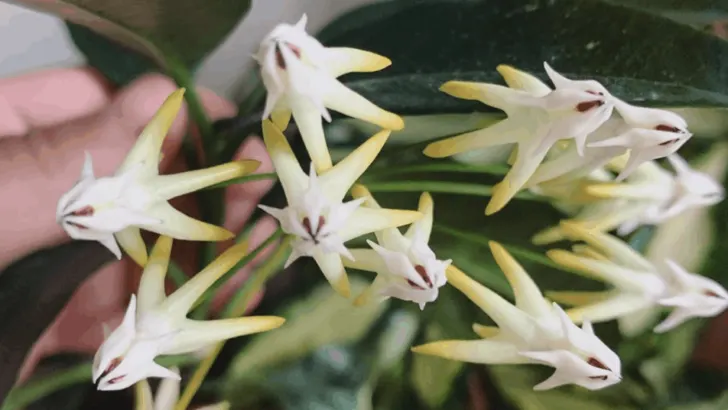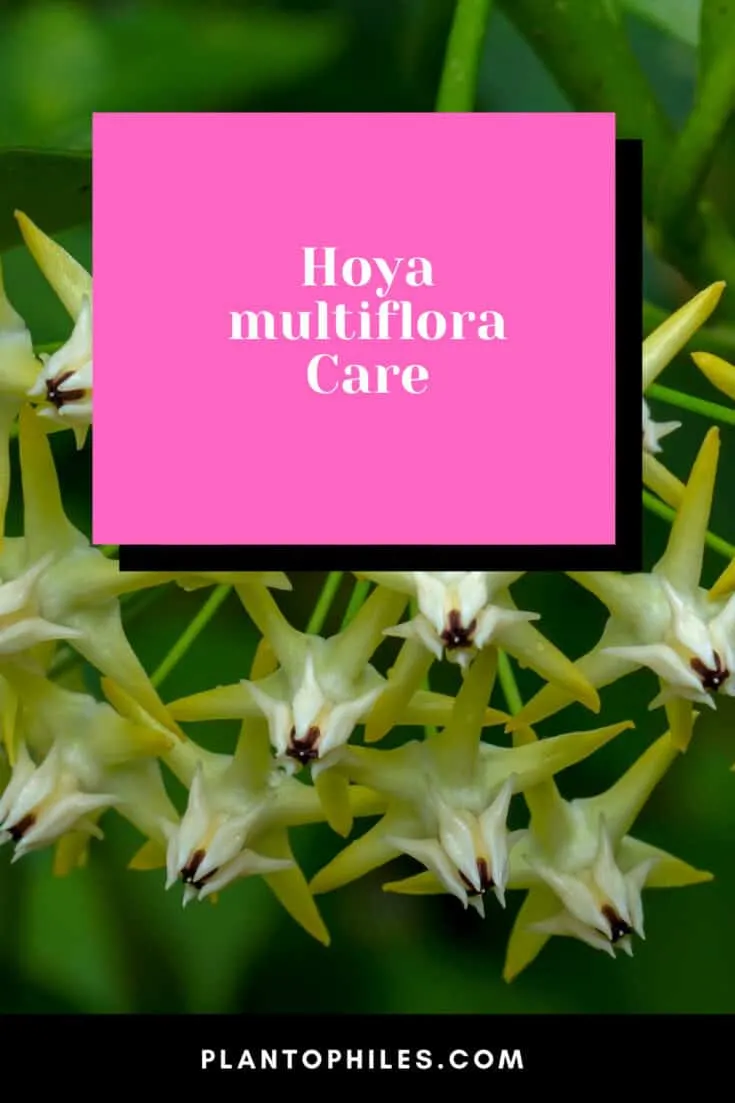Hoya multiflora or Shooting Star Hoya is a tropical species of plants in the Apocynaceae family and was discovered in Indonesia according to the Indonesian Journal of Forestry Research.
As the name indicates, Hoya Multiflora plants flower a lot and also frequently.
The stems of Hoya Multiflora lay on the ground but with erect or rising tips.
There are one or more of them, with smooth bark, light grey, yellowish when dry, with constant leaf scars.
Hoya Multiflora is also known with common names such as Shooting Star Hoya, Many Flower Hoya, Wax plant, and Porcelain flower.
Efficient to grow and bloom, the floral arrangement of this Hoya possesses large clusters of star-shaped flowers almost continuously all year round.
Its dense leaves, strong stems, and upright growth habit add a distinguishing presence to any array.
This plant may yield nectar at times and are glabrous throughout, except for the throat of the corolla.
Glabrous meaning smooth and corolla are the petals of a flower.
Let’s have a closer look at how to grow Hoya multiflora.
Hoya multiflora Care
To care for Hoya Multiflora provide bright indirect light. They grow best in a well-draining soil mix consisting of perlite and orchid mix. Water your Hoya plant just when the soil is dry to the touch. Grow this plant in a temperature range of 64°F to 84°F (18°C – 29°C). Fertilize every 2-3 weeks during the growing season in spring and summer using a balanced fertilizer.
Table of Contents
Basic Plant Care for Hoya Multiflora
Soil
For adequate growth, Hoyas need well-draining soil, sphagnum moss, or orchid substrate.
One-part peat, one-part perlite, and one-part orchid mix are the best potting mix for Hoyas.
To keep the roots safe and prevent them from drying out, this kind of soil ensures plenty of airflow.
You should use a well-aerated, fast-draining soil for the Hoya plant. Apply a little sand to the soil to ease it even more if the soil appears to be hard.
A cactus mix or potting medium for succulents is another acceptable soil type for growing Hoyas.
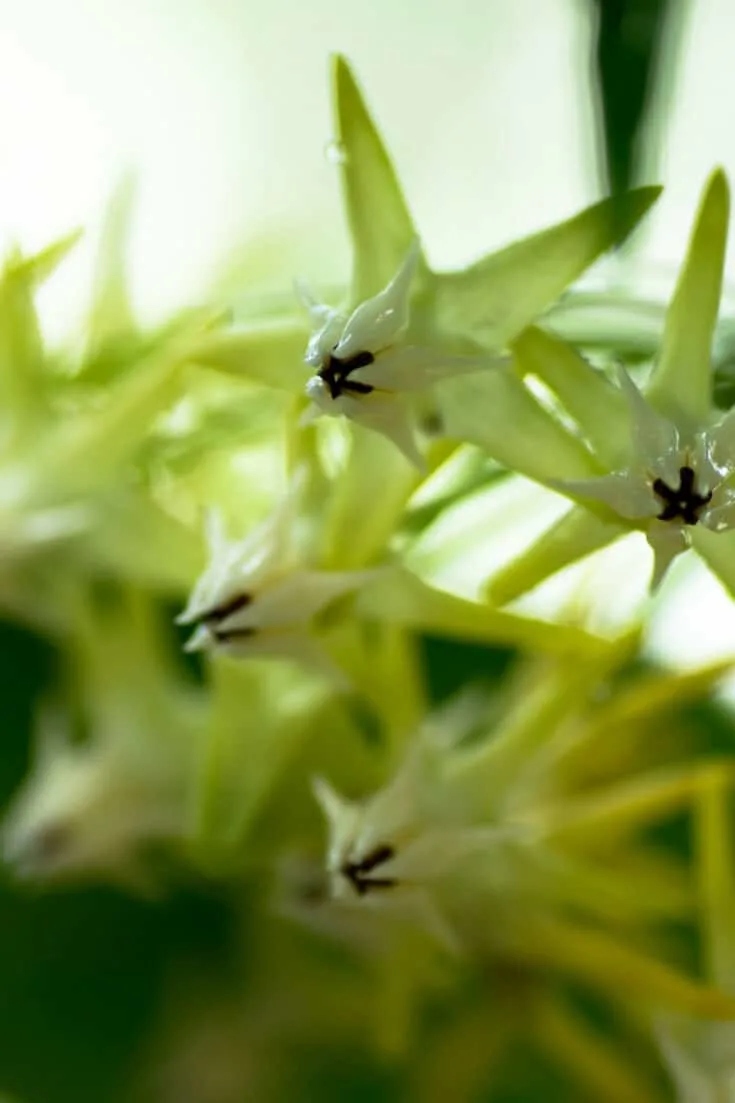
Hoya multiflora requires well-draining soil
Water
The main tip for watering a Hoya Multiflora is to wait until the soil’s top 1 inch (2.5 cm) has dried out.
To remember when to water your plant, you should keep track of air temperature and humidity in which your plant is growing.
Overwatering your Hoya plant is the worst thing you can do to it while caring.
If you allow your plant to sit in soggy and damp soil, there are chances it will get root rot and may die due to fungal diseases.
To keep your plant healthy, make sure to have drainage holes in your pot.
You can also prefer the use of pebbles to allow for better drainage and airflow.
An undeniable sign of overwatering your Hoya Multiflora is that the leaves start to turn yellow and feel mushy.
If you see the leaves turning yellow and soil being soggy, stop watering the plant for at least until the soil partly dries.
You might need to repot your plant to save it from dying due to overwatering in extreme cases.
One best watering tip is to never let your plant sit in a tray or saucer of water.
You can probably wind up with soil that is waterlogged, diseased roots, and fungal issues.
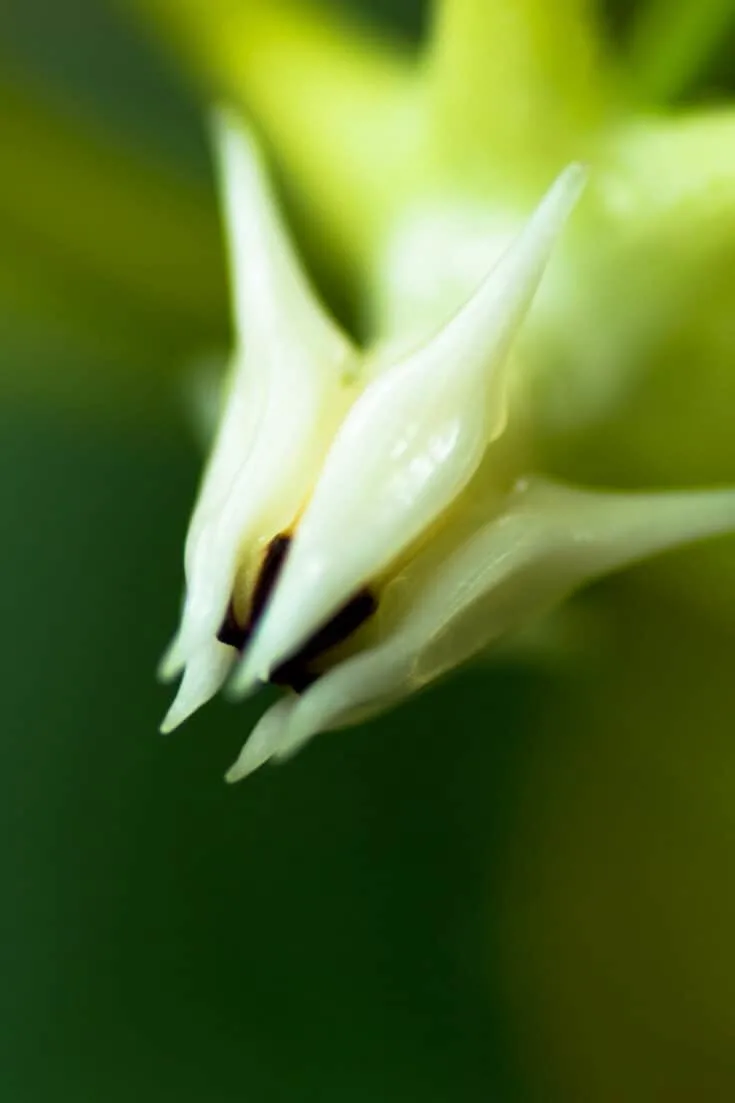
Hoya multiflora produces nectar
Light
Hoya Multiflora plants grow best in bright indirect sunlight.
They require around 6 hours of sunshine every day.
Hoya Multiflora can also be grown in shady areas or rooms with a moderate amount of light, but they will rarely bloom in this condition.
The perfect place for your Hoya Multiflora is a south or west-facing room.
When growing your Hoya plant, keep a keen watch on the color of the plant’s leaves.
The leaves on the sunny side look healthier but will turn yellow if too much direct sunlight is given. In these cases, keep rotating your plant now and then.
You can put your Hoya multiflora plant outdoors during the summer season. Remember to put your Hoya Multiflora plant in a shady area away from direct sunlight to keep it safe from damage.
Temperature
Hoya multiflora mature well and flourish in temperatures between 64°F to 84°F (18°C – 29°C)
Thus average room temperature will work well for your Hoya Multiflora vines.
To ensure that your Hoya Multiflora is not stressed, try to avoid sudden temperature changes for the plant.
To keep your Hoya plant healthy, keep it away from extreme cold temperatures and hot radiators.
You can keep your Hoya outside if you live in a warmer climate, as long as the temperature conditions are favorable.
However, you will probably need to put your Hoya indoors when the temperatures start to drop in the fall and winter.
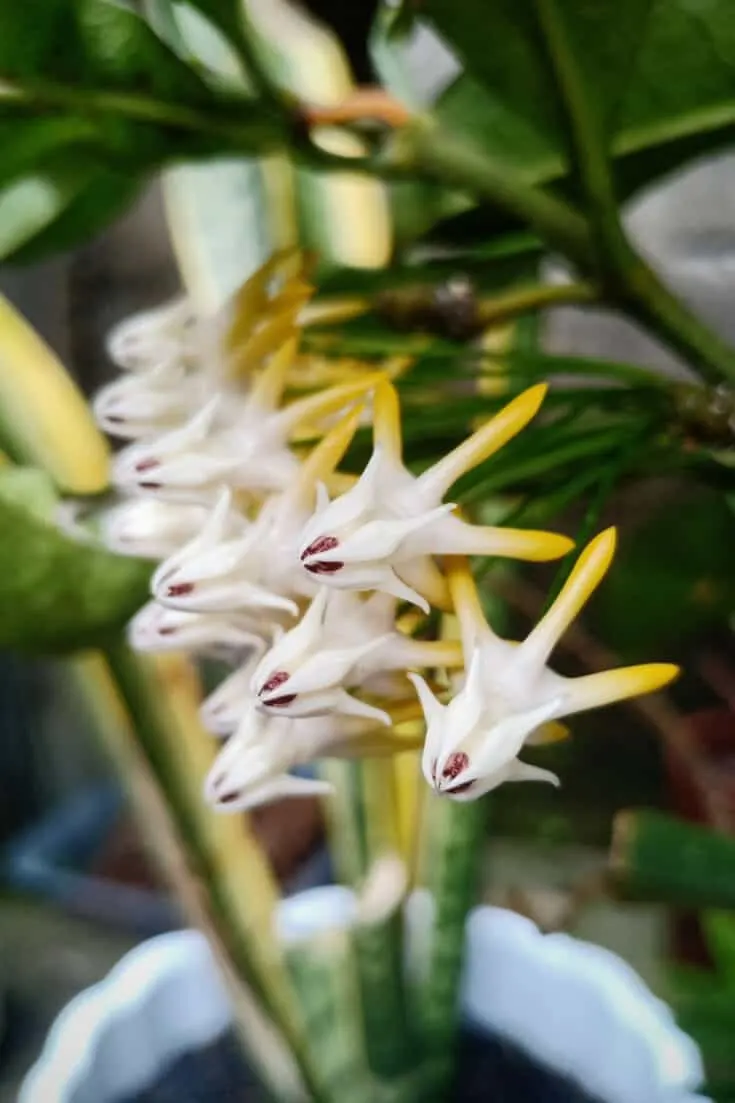
Hoya multiflora blooms multiple times a year
Humidity
Hoya multiflora thrives best in humidity between 60 and 80 percent.
This doesn’t mean y0u can’t grow these houseplants’ lower humidity as well.
Use a humidifier if you can, or put a container on a pebble tray containing water.
It also depends on air quality to maintain humidity just right for your Hoya. Household heating keeps the air dry.
So you may need to mist your plants in winter twice a day. Some Hoya species are more challenging to care for than others, so remember this.
Wilted leaves or slow growth are indicators you need to increase humidity.
To further improve humidity, make sure the soil is slightly moist and give the leaves a good misting.
Fertilizer
When it comes to fertilizer, Hoya Multiflora plants do not require a lot of it.
Fertilize with an organic fertilizer every 2 to 3 weeks in the growing season (spring and summer).
It would be supreme to hold off your plant feeding in the fall and winter, as plants’ growth becomes almost inactive.
A nitrogen-rich fertilizer can foster healthy growth as the Hoya matures.
Switch to a phosphorus-rich fertilizer to get good, vibrant flowers when you know that your plant is about to flower.
Flush the soil between feeding to care efficiently for your Hoya, and avoid root burn.
This is done by watering your succulent houseplant thoroughly and allowing all the excess water to drain.
This flushing helps prevent mineral salts in the soil from accumulating, which could delay growth.
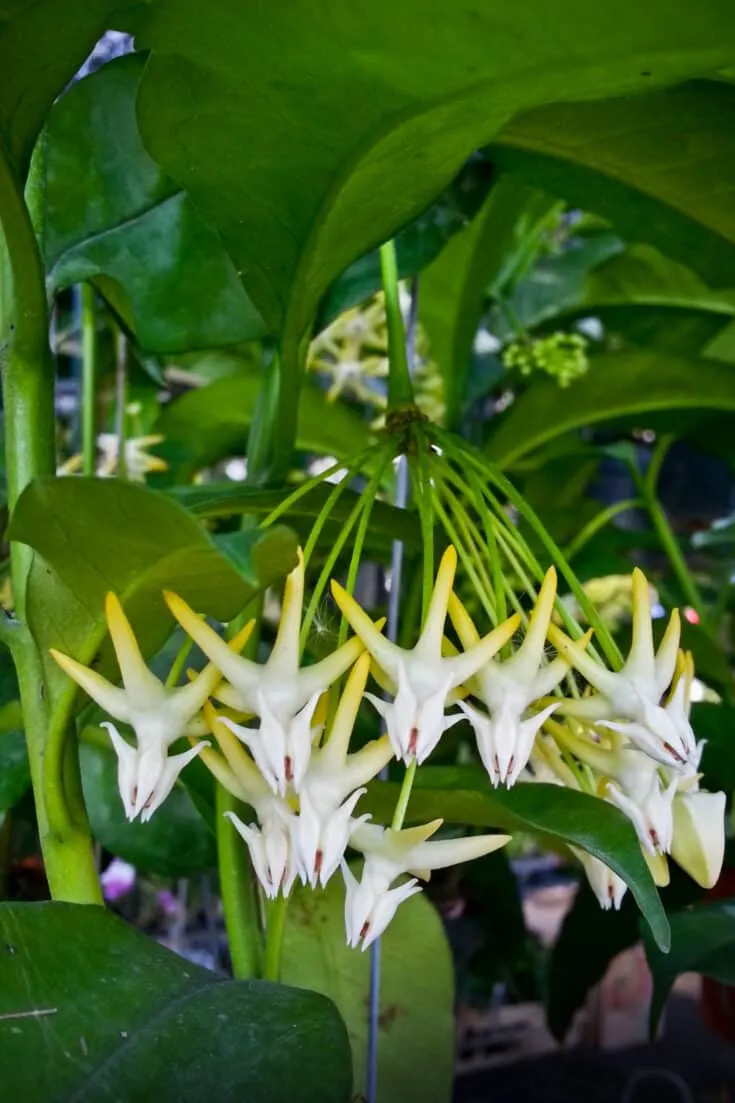
Hoya multiflora is also called Shooting Star Hoya and you can clearly see why
Repotting
Hoyas are not fast-growing plants, so they don’t have to be repotted often. Hoyas plants thrive in the same pot if they are left alone.
Thereby, just repot your Hoya when you find that it has stopped rising or become rootbound due to drainage issues.
Choosing a pot of 1 to 2 inches (2.5-5 cm) wider than the current pot if you need to repot your Hoya Multiflora plant is preferred.
Take the plant gently out of its current container and shake off the excess soil.
If required, check the root system for soggy, dead, or shriveled roots and prune.
Place your Hoya Multiflora in a separate pot with a fresh medium for potting.
Carefully water and position the plant to promote healthy growth in a clear, sunny spot.
The ideal time to repot a Hoya is when it’s healthiest in spring or early summer.
Pruning
Hoyas can become leggy vines if left unpruned and can look untidy. Pruning helps to stimulate growth and give a bushier look to the Hoya vine.
Cut back any brown or dead stems to prune the Hoya. It would help if you pruned them at the node using leggy, vigorous stems.
In order not to cut off the peduncle, you should take caution while pruning the stem where the flowers are growing on the plant.
It will help ensure that your houseplants create colorful flowers year after year when you leave this flowering stem.
Propagation
The fact that they are easy to propagate is one of the best things about growing Hoyas at home.
- You would take the cuttings with 2 or 3 nodes on them when the Hoya is pruned.
- Root the cuttings in a small jar of water by inserting the cut ends in it. You should discover new roots developing after a few weeks.
- The cutting can also be directly inserted into potting soil.
- To raise the humidity, enclose the pot with a plastic bag and keep the soil moist. After four weeks, the plant should root.
- It will take a few more weeks to develop into a mature plant.
Blooms
It has vast clusters of white and yellow flowers with a waxy texture from early spring to late summer, varying slightly with age.
The starry flowers are very unusual, of arrow-shaped petals, a wide stamen column with backward-bending and look similar to a “shooting star.”
Each of the Hoya Multiflora has a brown core, and each cluster contains up to forty fragrant flowers.
The flowers are 0.63-0.8 inches (1.6cm – 2.0cm) in length, heavily fragrant, rocket-like, and contain lots of nectar.
Especially late at night or early in the morning, they have an indistinct lemon like smell.
Flowers last up to 12 days and occur from early spring until late summer—the Hoya Multiflora plant fruits in the fall season.
Growth
Hoya multiflora is a climbing plant that is 98 inches tall (249cm), but more often, it has a compact, erect, shrubby development of only about 31.5 inches in height (80cm) and does not branch on its own.
Common Problems for Hoya Multiflora
Mealybugs
Mealybugs are difficult to find as they tend to hide in plant nooks and corners.
In appearance, they are white when on top of leaves, which further decreases the ability to detect them.
They use their mouths to extract the leaves’ sap, causing the leaves to turn yellow and curl up.
In the initial phases of infestation, they are easy to manage if detected.
Just get a cotton ball to regulate them, dip it in rubbing alcohol, then clean the plant with it.
Then use pesticide spray if the infestation increases. It might be safer for your plant to use a more sustainable substitute, such as neem oil.
Spider Mites
For some reason, Hoya Multiflora is supposed to be kept in humid climatic conditions, and spider mites are one of these reasons.
Due to the air being dry, spider mites enter plants and go unnoticed before a major infestation happens.
You can entirely rinse your plant by blowing the front and backside of the leaves with water.
Blast water onto the stems to shake off some of the spider mites.
Throughout the week, you possibly need to apply pesticides on the plant multiple times.
Aphids
They are insignificant, soft-bodied insects that feed on plants by sucking out nutrient-rich liquids.
Aphids reproduce rapidly, so it’s crucial to keep them under control before reproduction begins.
If a sticky material covers the leaves or roots, that is an indication that aphids may have been sipping sap.
Spray the plant’s leaves with cold water to remove them. Dust plants with flour if you’ve had a massive aphid invasion.
This way, pests become constipated. Neem oil and insecticidal soaps are of great benefit for killing aphids.
Sooty Molds
Another specific Hoya plant disease is Sooty Mold.
Due to the nectar-producing feature of the Hoya Multiflora plant, this species is susceptible to sooty mold.
On the plant’s leaves, the illness will appear as black molds.
The mold seems to cling to the sap or nectar of the plant, making it worse. Due to their honeydew production, aphids may also give rise to sooty mold.
It is easy to get rid of this disease.
Use a wet cloth and wipe the molds off. You can spray antibacterial spray on the cloth for better results.
Scale Bugs
The scale bug is tiny, round and flat, with a defensive tan to brown cave-like cover.
Scale typically targets the bottoms of the leaves or around the joints of the leaf.
Scale insects flourish in hot, dry atmospheres. Scale-damaged plants look shrunken, leaves turn yellow, and may start dropping from the plant.
There are several methods used to get rid of the scale bugs.
You can use a cotton ball dipped in rubbing alcohol to clean the bugs. The use of insecticide sprays and neem oil is also effective.
If there is a heavy infestation, it is best to throw the infected plant away.
Tips for Growing Hoya Multiflora
- Monitor the bugs periodically underneath the leaves and nodes, and better not to ever let it get to a full-blown infestation. If you see any kind of bugs, fix them with alcohol or insecticides.
- Never expose your plant to extreme cold weather or direct sunlight.
- Keep your Hoya plant at a normal humidity level or, if possible, between 60%-80% of humidity level.
- Frequently water your plant but never overwater it as plant left in a waterlogged mixture will eventually die.
- Keep your Hoya Multiflora plant in a pot that has a good drainage system.
Frequently Asked Questions about Hoya Multiflora
What will be the best fertilizer for my Hoya Multiflora?
As Hoyas are primarily foliage plants, the nutrient ratio specified on the plant food must have a higher nitrogen level. Any 2:1:2 or 3:1:2 food is adequate to maintain the plant in perfect health.
What sort of light does a Hoya Multiflora require?
Sunlight is essential for a Hoya plant, but indirect sunlight is better. Keeping the plant hanging directly in your window would lead the leaves to burn from the sun’s intense light.
How habitually do Hoyas blossom?
Some species of hoyas flower in spring and summer, some flowers in autumn and winter, and some occasionally bloom during the year.
Are Hoya Multiflora plants toxic?
Hoyas is a genus of Asclepias or common milkweed. They all contain a milky sap laden with latex and are known to be toxic. Also, someone with a latex allergy should resist touching the plant.
How often should you mist your Hoya plant?
Some plant owners like praying the leaves. Misting is useful to increase humidity and to tidy the leaves. When Hoya is budding or in bloom, do not mist.
Does Hoya Multiflora prefer sun or shade?
They are mid-level light tolerant, although they require moderate light or some early sun to bloom well and tend to be maintained in the same pot for years.
Conclusion
Hoyas are an epiphytic plant type, which indicates that they can grow on the surface of trees, large shrubs, and bushes of other plants.
The roots consume nutrients from the air or the host plant.
Using coco chips, bark chips, or sphagnum moss, you can also grow Hoyas.
In this instance, to prevent the roots from being too dry, you will need to water your Hoya more periodically.
For the porch or patio or windowsill, Hoyas make simple, gratifying, and long-lived enhancements.
They enjoy high indirect sunlight and healthy, well-draining soil and should be allowed to get relatively dry between waterings.
This plant is cultivated for magnificent flowers. Although these flowers aren’t fragrant as other Hoya plants, they generate abundant sugary, sticky nectar attraction as pollinators for moths and bats.
Most Hoyas are twining climbers to trailing plants, and although hanging baskets often make a beautiful display, they can be used to have a good impact on a small trellis.
These are convenient and rewarding plants, as well as challenging and not forgiving when you forget about water.

